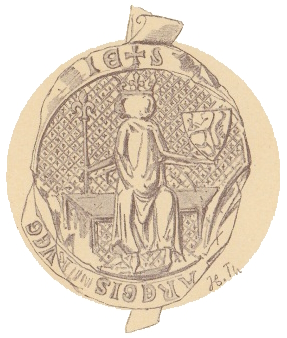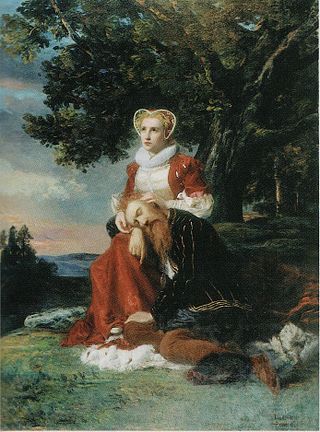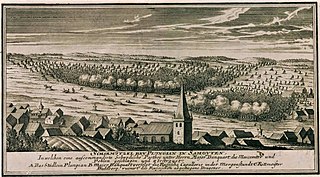
Haakon VI, also known as Håkan Magnusson, was King of Norway from 1343 until his death and King of Sweden between 1362 and 1364. He is sometimes known as Haakon Magnusson the Younger to distinguish him from his great-grandfather, Haakon V.

The invasion of Russia by Charles XII of Sweden was a campaign undertaken during the Great Northern War between Sweden and the allied states of Russia, Poland, and Denmark. The invasion began with Charles's crossing of the Vistula on 1 January 1708, and effectively ended with the Swedish defeat in the Battle of Poltava on 8 July 1709, though Charles continued to pose a military threat to Russia for several years while under the protection of the Ottoman Turks.
Joran, Jöran or Jøran is a masculine given name. Bearers include:

The Battle of Krasnokutsk–Gorodnoye took place on February 20–22, 1709, in the Swedish campaign of Russia during the Great Northern War. The Swedish troops were directly led by Charles XII of Sweden who pursued a force of Russians commanded by Otto Rudolf von der Schaumburg from the minor battle of Krasnokutsk to the town of Gorodnoye (Horodnje) where a new battle took place, with the Russians now commanded by Karl Evald von Rönne. The Swedes were victorious but cancelled their offensive as night fell.

The Swedish invasion of Poland (1701–1706), also known as Charles XII's invasion of Poland or the Polish front of the Great Northern War, was a conflict in eastern Europe overshadowed by the ongoing Great Northern War fought between the Swedish Empire against the Russian Empire, Denmark-Norway, Saxony and the Polish–Lithuanian Commonwealth. The Polish front was a major part of the greater conflict, and it included some decisive battles in favor of the Swedes that contributed to the length of the war.
The Battle of Grodno (1708) was the first battle of the Swedish invasion of Russia on 26 January 1708, during the Great Northern War. Grodno was a city of the Polish–Lithuanian Commonwealth at this time.
The Battle of Desna, also known as the Crossing of the Desna River, was a three-day operation which took place on 11 to 13 November 1708 during the Swedish invasion of Russia of the Great Northern War. The Swedes under Charles XII tried to prevent the Russians from seizing the town of Baturyn, by crossing the river of Desna which was strongly defended by the Russian Army of 4,000 men under Ludwig Nicolaus von Hallart. On 11 November the Swedes attempted to build a bridge going over the river, however, the heavy fire from the Russians made for slow progress and so, on 12 November, Berndt Otto Stackelberg with 600 men crossed the river on rafts to cover the ongoing construction of the bridge. The Russians counterattacked but were fiercely repulsed by the outnumbered Swedish defenders. The Russians retreated on 13 November leaving about 356–800 men dead while having another 900–1,000 wounded. The crossing had been successful and was often compared to Alexander the Great's crossing of the Granicus. However, the Swedes were too late to defend Baturyn and the city had already been destroyed in the Sack of Baturyn.
The Battle of the Neva took place on September 9, 1708, during the Ingrian campaign of 1708 during the Great Northern War.
Events from the year 1958 in Sweden

The following events occurred in the year 1568 in Sweden.
This article is about events from the year 1558 in Sweden.

Events from the year 1677 in Sweden
The Battle of Valkininkai took place at 6 March 1706 close to the town of Valkininkai in the Grand Duchy of Lithuania during the Great Northern War.
Nordberg is a surname. Notable people with the surname include:
Olle Nordberg is a Swedish professional golfer who played on the Asian Tour and European Tour.

The Storming of Lemberg on September 6, 1704, was a successful Swedish assault on the town of Lemberg (Lviv), in the Polish–Lithuanian Commonwealth, during the Great Northern War.
Mats Nordberg was a Swedish politician and member of the Riksdag representing the Sweden Democrats party for the constituency of Dalarna County. Nordberg also worked as a tree surgeon and in forestry. He served on Committee on the Environment, Public Health and Consumer Policy in the Swedish parliament.

The Drabant Corps of Charles XII was the most prestigious unit in the Swedish Army during the time of the Great Northern War. As a result of the reforms of 1700, all personnel in the corps received an officer's rank with increased wages, while its size was eventually set at 168 men. Those serving as Drabants were almost exclusively recruited from the Swedish Empire, with most coming from Sweden. The corps was issued the finest weapons, horses, and clothing was often adorned with gold lacing. They fought according to the cavalry regulations of the Caroleans, emphasizing the cold-steel charge in slight wedge formations, knee behind knee, over the more common caracole. This strategy allowed them to function as a bodyguard for the king as well as an elite combat unit, often playing a crucial role in the battles despite their relatively small size. During the war, the corps frequently marched with the main army and the king, fighting in most battles.

The Battle of Palanga, or the Battle of Polangen, was fought on 13 February 1705 between a Swedish army commanded by Joachim Danckwardt and a Russian–Lithuanian army under Iwan Stephan Gogaron Morbirun. Danckwardt was sent to Palanga in Samogitia with 387 cavalry to reopen the line of communication between Courland and eastern Prussia, in which he was successful. The Russians and Lithuanians gathered a force of about 2,000 cavalry and intercepted him at Palanga. Danckwardt was able to fend off their attacks for a while, before winning the battle with a counterattack against their lines. The Swedish detachment then participated in Lewenhaupt's short-lived offensive in Samogitia. At the Battle of Gemauerthof later that year, Danckwardt was killed in action.

The Swedish invasion of Saxony took place in 1706 during the Great Northern War, which began in 1700 when Russia, Denmark–Norway, and Saxony attacked Sweden or its ally, Holstein-Gottorp. To force Augustus II the Strong out of the war, who was the elector of Saxony and king in the Polish–Lithuanian Commonwealth, Charles XII of Sweden invaded the Commonwealth; Augustus was dethroned in 1704, and, after a devastating Saxon defeat at Fraustadt, Charles XII marched against Saxony in 1706 with 20,000 men.










